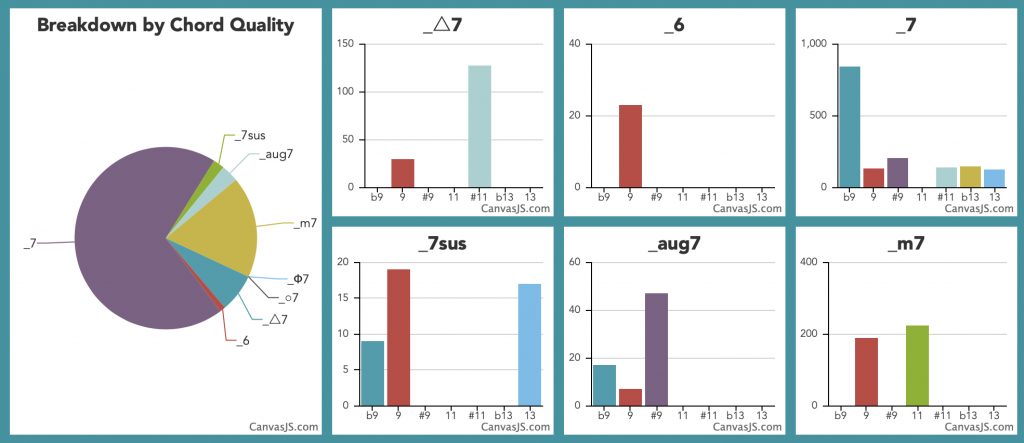Here to share a quick summary and findings from “Tension” menu of “Jazz Standards Statistics“.
For tension chord analysis, we have several viewpoints; “where” tension chord appears, “what chord quality” have more tensions, “which tension” is used, etc. For example 5_7(#9) chord is, dominant 7th chord (“what chord quality”) occurring at 5 (“where”) with #9 (“which tension”). This time, firstly let’s have a look on “what chord quality” and “which tension”, in comparison between Major key songs and minor one.

Above : in Major key songs / Below : in minor key songs

These are charts that show “what chord quality” has more tensions (left pie chart) and “which tension” each chord quality has (right six charts).
In comparison of Major key songs and minor key songs, a slight difference is found at _m7 chord ratio in “what chord quality” pie chart. But other than that, they look quite same.
Now, let’s have a look on histograms which show “where” tension chords appear.


Again, sorry for squeezed labels. You can pinch and zoom at the dashboard.
At a first glance, this time, differences are clearly found. But anyway let’s look at similarity first. As a common tendency, big peaks are found at 5, and small peaks are found at 1 (and 2) both in Major key and minor key. On the other hand, differences. In minor key, other than peaks at 5 and 1, there are not many outstanding peaks (maybe just at 2?). Meanwhile in Major key, other peaks are founds at 3, 6 and 7.
Here is a top 7 table.
| Major Key Songs | minor Key Songs | |||
| 1 | 6_7(b9) | 10.8% | 5_7(b9) | 24.8% |
| 2 | 3_7(b9) | 6.0% | 1_m7(11) | 6.7% |
| 3 | 5_7(b9) | 5.7% | 1_m7(9) | 5.2% |
| 4 | 7_7(b9) | 3.6% | 5_7(b13) | 5.0% |
| 5 | 2_7(b9) | 2.4% | 1_7(b9) | 4.6% |
| 6 | 1_6(9) | 2.2% | 5_7(#9) | 4.1% |
| 7 | 5_7(9) | 2.2% | 2_7(b9) | 3.1% |

One Reply to “Tensions”